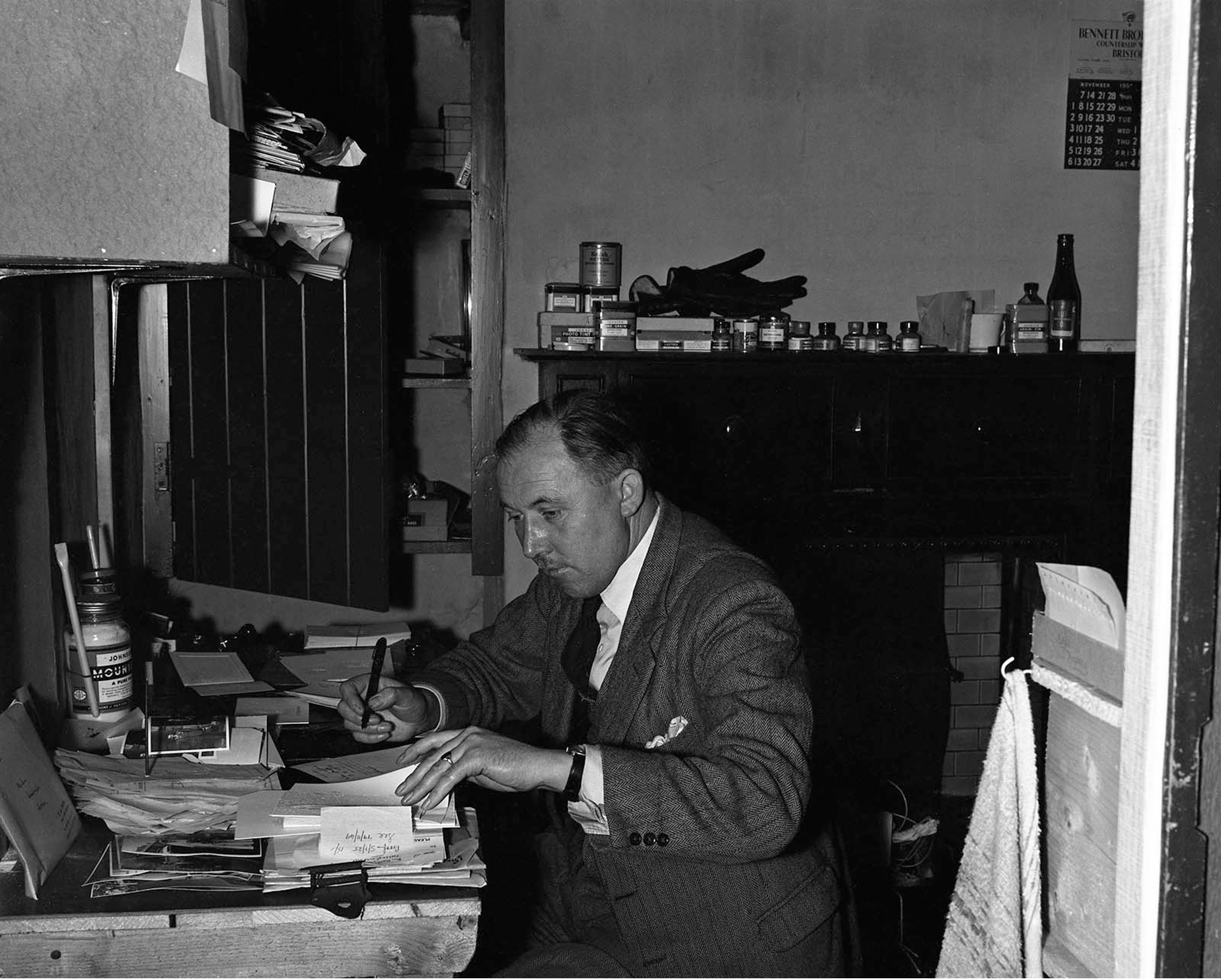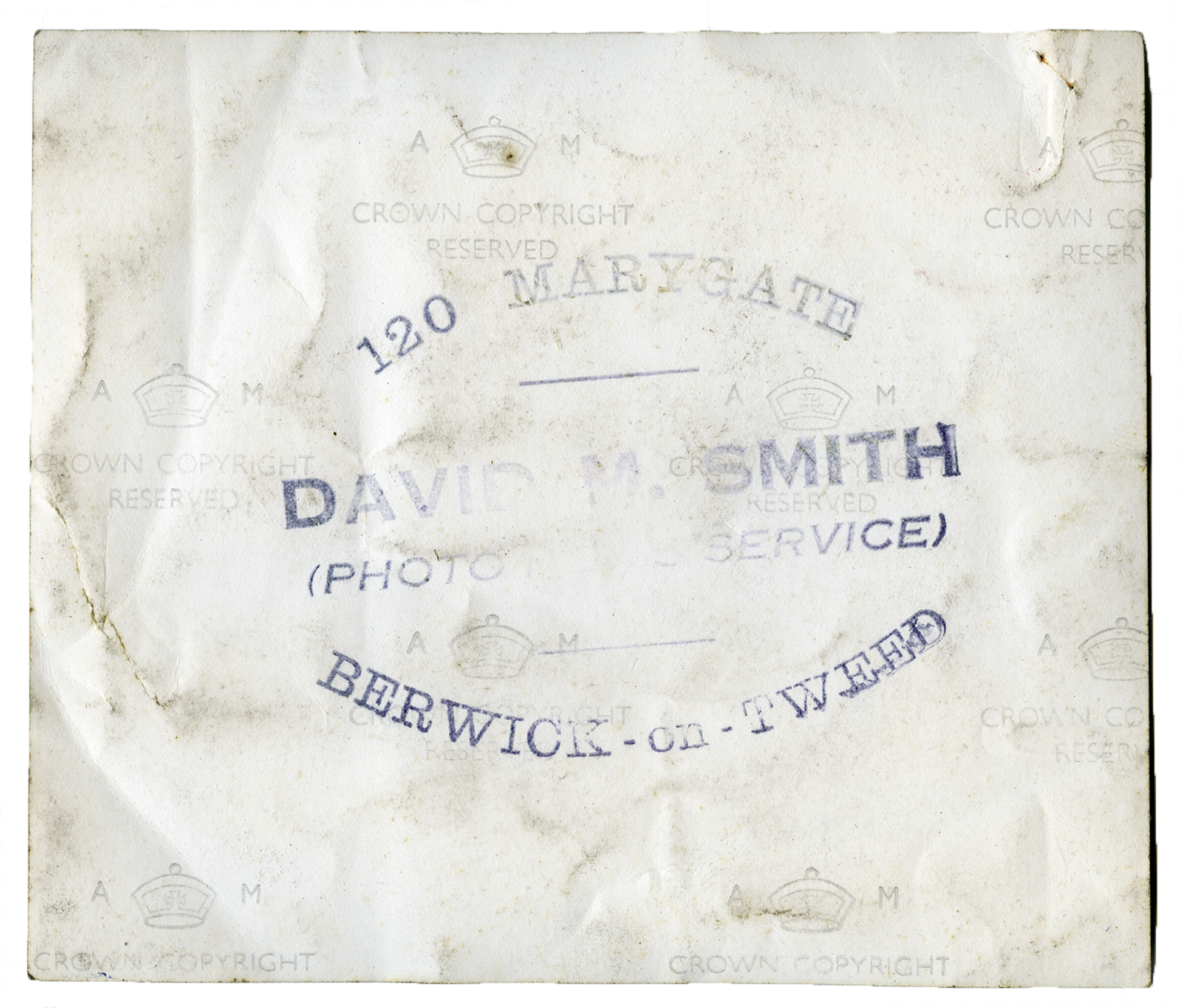In the beginning…
Where better to start a blog about the Photo Centre than at the very beginning! The business was founded by David M. Smith in 1951, but it’s definitely worth taking a look at Mr Smith’s journey into journalism and at how he came to set up his own business.
In an interview in the 1990s David Smith said that on leaving school he decided he wanted to be a journalist. He wasn’t quite sure why. He’d never met a reporter, nor did he have any family connections with the world of newspapers, but that was what he wanted to be.
David M. Smith at work, 1955.
He was born in Perth in 1914. His father was a police sergeant and through his work had a relationship with the local press. On leaving Perth Academy, David Smith attended the Ross Commercial Training College where he learned shorthand and typing. Conveniently, next door to the college was the offices of The Perth Constitutional, one of two newspapers in the city. In 1930, when Smith was 16, the editor promised to start him in a job as a junior reporter. His journey had begun.
The rules of the job were soon being drummed into him. His first assignment was a report on a cricket match one Saturday afternoon. On the Monday morning he went to his desk at the office and began to write his report. The editor, Peter Winton, came over to see what he was working on. Discovering that he was writing up an event which took place 2 days ago he hit the roof. ‘You’ll have to learn. If you’re at a job today, you write the job today – it doesn’t matter when you bloody well finish! You don’t carry news over a day!’.
David appears to have been a natural – taking to the job like a duck to water. Even the fact that he began as a junior reporter suggests the editor saw promise. From the beginning the work was varied, as you would expect with a local paper. News, court cases, council meetings, sports, you name it, it had to be covered. Proofreading the commercial work which was also printed in the Constitutional office was excellent training for his journalistic work too.
By 1933, David Smith was well on his way up the ladder. He was appointed News Editor and began the task of re-modelling the outdated layout of the Constitutional. Probably the most significant change which he made was the introduction of a page of photographs. Smith approached the owner of the paper, Sir Thomas Hunter, to suggest that they could take their own photographs rather than buying them in. ‘How are you going to do that!?’ he said. David replied, ‘I’ll learn the camera and take them myself’. As well as writing the copy, from this day onwards he also took the photographs which would accompany the text.
Prior to this moment Smith had no interest in photography and certainly didn’t possess the skill to take photographs to a quality good enough for publication. He navigated this small issue with the help of Bob Watson, the chief photographer of the rival newspaper in Perth, the Advertiser. Watson taught Smith how to use a camera, no small task when you remember the cumbersome equipment which was in use at the time. This was a far cry from the point, click and instant results of today’s cameras. It was through photography that Smith realised that it was faces which sold papers. If for instance you went to a dance on a Friday night and were photographed by the press in a crowd, you were obviously going to buy the paper the following week to see the result! This is a fact which stayed with him for his whole career.
David met his future wife Charlotte whilst at the Constitutional in around 1936, and in 1938 they became engaged. Around this time he felt the need to move South to work for one of the national newspapers in England. As a staging post he took a job on an 18 month contract as chief reporter at the Berwick Advertiser in Berwick-upon-Tweed. His reason behind choosing Berwick was to learn the basics of court and local government reporting on the English side of the border, whilst keeping his hand in on the Scottish side as the Advertiser covered both sides of the border.
The Berwick Advertiser Office, c. 1958
In 1939 David married Charlotte Buchannan, only days before the outbreak of the Second World War. The couple moved into a house in Tweedmouth. Like the majority of the male population of Britain, in May 1940 David was called up to serve in the army. Charlotte, like her husband, knew the workings of a newspaper well. During the war years she took over her husband’s post at the Advertiser, acting as chief reporter in his absence. Indeed she was the only reporter at the time as the rest were off fighting. This put two women at the top of the paper as the Editor at this time was Miss Mary Grey.
After his spell in the Royal Signals where he travelled to Italy, Palestine, India, Australia and Ceylon amongst other places, David returned to Berwick in 1946. Until now the Advertiser had been owned and managed by Major Smail but on his death the ownership of the paper passed to his half-cousin Col. James I.M. Smail. Shortly after in 1948, Miss Grey retired and David became the Editor of the Berwick Advertiser. Col. Smail had no experience of running a newspaper which in the beginning was not an issue as he kept out of the editorial side of things.
The Berwick Advertiser Photographic Department, c. 1958.
As he had done with the Constitutional, David introduced photographs to the Advertiser, opening a photographic department in 1949/1950. The fact that he was taking photographs and writing too, was very unusual at the time and got him into a bit of trouble with the National Union of Journalists but this was only short-lived. As time went on, Smith employed photographers to cover a wider number of events. As well as images appearing in the Advertiser, they were also sent to a wide range of other newspapers when the story had a connection to other areas or if it was of national importance. Smith had been sending copy to other papers throughout his career, supplementing his wage and spreading his name and reputation. Correspondence from the time shows the variety of outlets he was supplying, from the all main national newspapers to the B.B.C., The New York Times and countless other publications. Many journalists did this and at the Advertiser, Smith encouraged the other reporters to do the same.
As the 1950s dawned, David’s relationship with Col. Smail, which had always been a good one, began to fray and in 1951 deteriorated drastically. Smail accused Smith of disloyalty to the paper for supplying news to other publications. Having increased the circulation of the Advertiser from 2,500 to 7,500 copies a week in just 2 years, he saw this as an insult and gave a months notice. In his own words, “So I finished at The Advertiser on the Friday, and started my own freelance business on the Monday - plunged in immediately.”
A back stamp for a print from D.M. Smith’s Photo-News Service. c. 1951
This huge network of contacts amongst Britain’s national and regional newspapers which he had fostered over the past 20 years came into play and David Smith never looked back. From humble beginnings in a leaky office above a plumbers shop at 120 Marygate, he went on to forge a successful press and commercial business which would thrive for the next 60 years.
Keep your eyes peeled for the next instalment of our blog which will tell the story of how ‘D. M. Smith – Photo-News Service’ became the ‘Photo Centre’ and went on to capture life in North Northumberland with his camera between 1951 and 2012.




